Architecture essay: Designs of Louise I. Kahn
Question
Task:
- Thinking the work relative to their own work
- Thinking about that building and work relevant/ Against relevant and selective practises, against other practise or architects and their key projects. ( so who is doing work at the same period that is relevant ( make a discussion / argument ) to look at how can we compare them and look at it.
- Look at the architectural qualities of the design ( look at the fabric/ the actual building itself) looking at the building in detail and consider how they might relate the relevant historical context, cultural values or the theoretical concerns at the time.
- And also consider making a link to the contemporary scenario as the conclusion?
Answer
As mentioned in the architecture essay, architecture is a mixture of both imagination and technology. The 20th century was the revolution of ‘modern architecture’, which was also called modernism. The architects of that time were determined towards declining the usage of 'neoclassical' designs and started to experiment with new patterns and techniques. It was widely influenced by the famous architects of that time to break the stereotypical 'institutionalized' perspective from society and replace it with modern imagination. In the 20th century, these revolutions had provided an immense success in the field of technology and architecture. Architects, such as James Stirling from Britain, Robin Boyd from Australia, and Phillip Johnson from America were famously called themselves the 'unorthodox' architectures. They have implemented advanced technologies and blend the modern style with old patterns to enhance a new style. They were also known to be the sailors of 'architecture movement' in the 20th century when they have changed the urban architecture works with bold experiments and technologies.
According to the research on architecture essay, Louise I. Kahn, a famous architecture from the 20th century is also known as breaking stereotypical styles and patterns from his building style. He had established his works with a mixture of 'monolithic' and 'monumental'. He was famous for blending the old 'medieval' and 'roman' architecture with a touch of modern technology and innovation. He had worked with several famous architectures of his time, such as Wharton Esherick, George Howe, and Oscar Stonorov, and established various workshops and designs for the future. He had represented some of his greatest work at that time. The main influential factor mentioned in the architecture essaybehind the modernization of architecture was the implementation of technologies, 'geometric patterns', effective usage of glasses, and steels. The architectures from the 20th century had promoted minimalism in the pattern and design of new buildings and decreased the usage of fancy 'ornament'. They were interested in showing the technical and modern aspects of their design. The readings considered in the architecture essay signify that Louise I. Kahn had created various architecture works and designs around the world. He is considered to be an inspiration to modern architecture.
“Kimbell Art Museum” in Taxes is one of the most significant architectural designs of the 20th century. This museum is the home of the private art collection by Velma and Kay Kimbell. It is the result of an extensive “research library”. Although, as stated in the architecture essay, the building is known for the architecture design as the building is the reflection of natural silver light. The building was built in 1972, and Kahn emphasized on its theme which is ‘natural light’ that reflects among the building’s ‘ceiling’ vaults, and ‘wing-shaped’ aluminum 'reflector' from the ceiling top reflects the "silvery vibe" across the hall . Each of the vaults is supported by 'barrel-shaped' vaulted 'portico'. The design is a mixture of modern and old architecture style. The absence of additional curves and designs among the building makes it an ideal example of the 'modern-era' architecture. However, the big arches and 'vault-shaped' ceiling is inspired by the "roman architecture". The building is the ideal example of "landscape plans” by modern architecture.
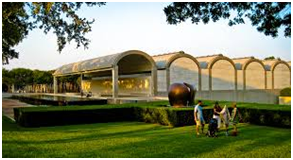
Fig 1: “Kimbell Art Museum” Outer Part
Kahn wanted to bring the natural light with the reflection technique by using influential color at the wall. The critical aspect of this architecture illustrated in the context of architecture essay is it’s a perfect blend of modern 21st century artistic expression with the Old Italian column design. He designed the vaults and curves of building in such a way that the sunlight can penetrate through those curves and spread natural light.
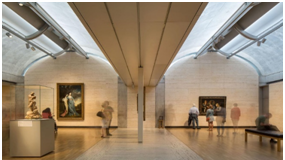
Fig 2: “Kimbell Art Museum” Interior with ‘Natural Silver’ Tone
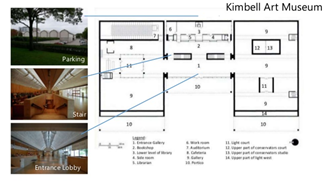
Fig 3: Architectural Design of “Kimbell Art Museum”
“First Unitarian Church” of Rochester is considered to be a significant work of architecture in the field of “religious architecture” of all time. Kahn completed the architectural and construction process
Lesser, Wendy. 2017. Walking Through the Kimbell. March 3. Accessed May 29, 2020. https://fsgworkinprogress.com/2017/03/23/walking-through-the-kimbell/. Kimbell Art Museum. 2020. ARCHITECTURE. Accessed May 29, 2020. https://www.kimbellart.org/art-architecture/architecture/kahn-building. Bintu, Nurjahan. 2018. Kimbell art museum. September 15. Accessed May 2020, 2020. https://www.slideshare.net/NurjahanBintu/kimbell-art-museum.
construction process in 1962. The external design of the building is noticed for its unique ‘folded brick’ design that creates natural ‘light hoods’ with the sunlight. The internal ceiling design has consisted of ‘light towers’ that enables sunlight indirectly. This architectural project examined in the segments of architecture essay is famous for being one of the initial works of transforming a sketch design into a real building. The main significance behind this architectural work is to implement modern technology that allows the natural sunlight by influencing the structural aspect.
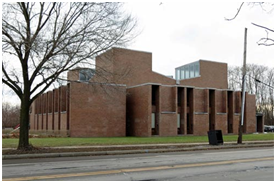
Fig 4: “First Unitarian Church” Main Complex
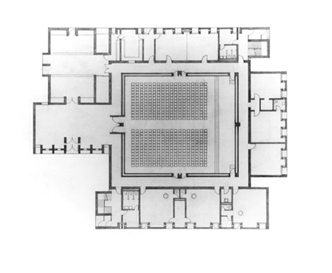
Fig 5: “First Unitarian Church” Architectural Draft Design
“Richards Medical Research Laboratories” is a campus-based laboratory building located inside the "University of Pennsylvania". Kahn designed the architectural work of the building and it built-in 1965. This particular architectural work portrayed in the architecture essay is considered to be the first notable work by Kahn in his early career. The laboratory is consisting of several towers interlinked with a mutual tower, which is the central 'service building'. The towers are supported by external column; eight columns for each tower. The support structure was built outside the construction site and assembled later through the crane. The "vertical columns" are supported by the external structure and each laboratory room is marked by windows at the corners of the building . The craft of this building is the expression of the modern age building system and aesthetic presentation. It is a perfect modernization of old column formed buildings with the advanced construction process.
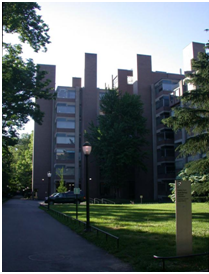
Fig 6: “Richards Laboratory” Building
The concept of not hiding the ‘constructional structure’ is to breaking the contemporary style in the architecture. It showcases the architectural work transparently and with minimal design.Herein architecture essay, it is the first step towards making the modern architecture acceptable to the people of that time.
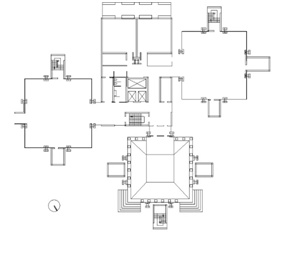
Fig 7: “Pinwheel” Style ‘Architecture Design’
"Yale Center for British Art" is an internal museum at "Yale University" for showcasing British 'artworks' and other collections. It is known to be the largest art museum dedicated to the British works outside the UK. It started with an American 'philanthropies’, Paul Mellon with his art collection in 1966. The museum building was designed and built by Kahn 1953. The interior of this building is remarkable. The external building is made of 'matte steel' and consists of 'reflective' glasses. The internal part is made from 'travertine' marble, 'Belgian linen', and white 'oak' . The collection and artworks are showcased through a 'diffused' light that is enlightened with natural sunlight. Kahn wanted the museum to have natural light inside the building to showcase the collections prominently. Later, when the museum authority went for renovating the building, they have discussed in the architecture essaythat the architecture idea and construction design of the site is the most complex one. They have spent a significant amount of money to restore the building as same as possible.
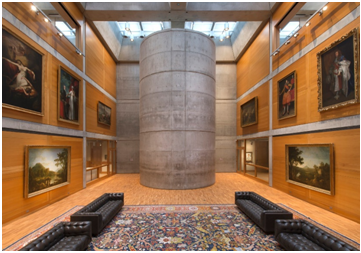
Fig 8: “Yale Center for British Art” Interior Design Made for Assessing ‘Natural Light’
The modern architects from 20th and 21st century considered in the architecture essay had revolutionized the usage of glass and allowing the natural light at the interior portion of the building. It was difficult at that time to work with glass in a broader area with implementing the contemporary technologies. New mounting technique has been implemented by Kahn in making these works conveniently.
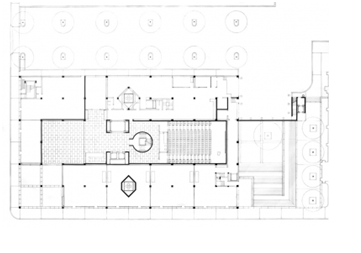
Fig 9: Museum Design Idea by Kahn
“Yale University Art Gallery” is known to be one of the oldest ‘university museum’ established in 1831. Louis I. Kahn had designed its main building and construction process during the end of 1940s. Kahn was the ‘architecture’ professor at “Yale University”, which influenced him to expand his imagination and 'architectural' approach by turning his ideas into practical implementation. As discussed in the architecture essay, it is considered to be the earliest major 'architecture work' in Kahn's career. The construction showcased the implementation of advanced technical aspects, such as a "tetrahedron" ceiling at the museum that can increase and decrease building height with its interlinked channeling with the structure . The construction of this advanced process was a joint work payoff by Kahn, and his colleague Tyng.Kahn had implemented his idea of “space frame” into this construction design. These ‘open’ spaces supported the complex in building the “central core”. The design of the building is so compact that it fits the classroom, office, and art gallery under a single roof.
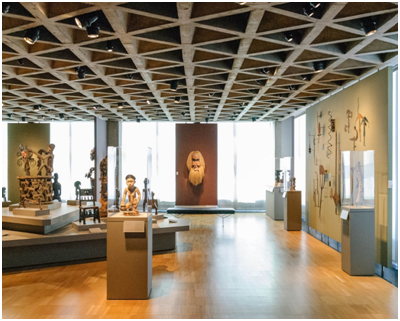
Fig 10: “Yale University Art Gallery” Internal ‘Ceiling’ Design
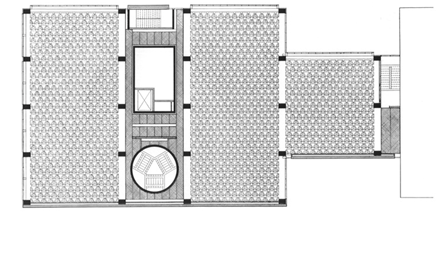
Fig 11: ‘Art Gallery’ Ceiling’s Plan by Kahn and Tyng
Kahn is briefly known for working with several architects during his working career. Wharton Esherick was a famous ‘wood sculpture’, had worked with Kahn and produced various designed and ideas. Together they had built a studio, which is now known as “Wharton Esherick Museum”. It is also widely known as the “1956 Workshop”, which was designed and build by Kahn. Many architecture students are interested in the works and ideas that had evolved at this very studio. During its building time, it was known to be the modern version of ‘rich architecture’ design . It is a 'one-story' house consists of different sizes of window panels with 'shutter' technique. It carries some valuable architecture designed and project works by both of them. As defined in the architecture essay, the internal ceiling of the building is curved and supported by wooden columns. It is an ideal representation of the 20th century’s ‘architecture design’ with the implementation of modern specifications. He had worked with many famous and well-known private and public architecture firms over the course of his career until he had started his firm. He had also collaborated with various famous architectures of that time, such as George Howe, Oscar Stonorov, and Wharton Esherick.
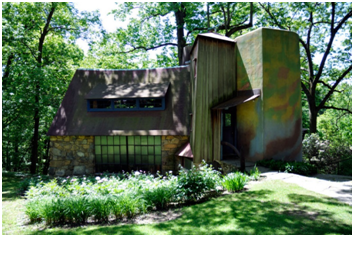
Fig 12: “Wharton Esherick Studio”
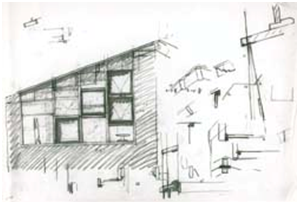
Fig 13: Sketch of the ‘Studio’ by Kahn
The “JatiyoSangshadBhaban” or the “National House of parliament” in Bangladesh was designed by the architect Louis Kahn. The architectural design of the complex portrayed through this discussion on architecture essay involves lakes, lawns, and residential areas for the parliament members. The major design philosophy of the architect Louis Kahn was to represent the cultural aspects of heritage in Bengal. It also emphasized on optimum utilization of the space provided. The building’s external lines are very simple along with big walls that are recessed deeply by several porticoes and huge geometrical shapes . The main building at the center of the complex comprises of three parts. They are the main plaza, the south plaza, and the presidential plaza. There exists an artificial lake surrounding the three parts. The lake is the symbol of the ‘riverain’ Bengal that pleases the eyes aesthetically.
The light-giving element within the building is introduced by the architect through a series of columns . They provide a solid framing that encourages the spacing of light. He created the huge columns in a hollow format so that they can provide their light through their comparatively thinner walls. The voids are rooms for the light and therefore it makes the column the maker of light taking complex shapes giving light to the spaces.
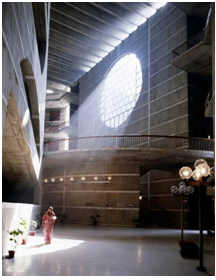
Fig 14: “Play of Light” at “JatiyaSangsadBhavan”
The “Phillips Exeter Academy Library” is a boarding school independently existing in New Hampshire. Louis Kahn designed the architecture of the building in a contemporary style in the year 1965. The library is structured into three rings of concentric squares. The research carried on this architecture essay shows that the outer ring is made up of load-bearing bricks and it includes the four walls of the exterior side. It involves several carrel desks inside the library. The middle ring is made up of concrete that is reinforced and helps in holding the heavy stacks of books. The inner ring is concerned with a dramatic atrium along with large openings in circular format within the walls. It reveals the floors of the stack of books.
The exterior architecture of the library includes a façade that is made up of teak wood panel bricks at many windows. It marks the location of the wooden pairs of carrels. The brick piers are relatively thicker to attract attention . The windows are wider in the top and the piers are thinner. The building possesses chamfered corners with a gap between the plate walls. Arcade circles the ground floor of the building and the walls are based on masonry masses without glasses having a void within them.
The interior architecture of the library involves a double circular staircase made up of concrete and is faced with travertine. Two large cross beams of concrete are intended to diffuse the entering light from the windows.
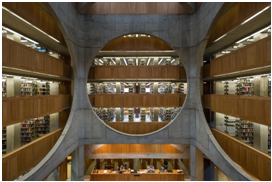
Fig 15: Interior of the Library
The “Indian Institute of Management” (IIM) is a public school of business situated in the state of Ahmedabad in Gujarat. In structuring the school’s architecture, Louis Kahn characterized the utility of the red bricks in exposure by using extensive geometric shapes in the academic blocks, huge outside corridors, and hostels . He collaborated the traditional Indian and the vernacular modern architecture in a skillful way for creating the building in terms of contemporary terms. According to the case scenario explored in the architecture essay, the building has a great influence among the students and visitors for its phenomenal architectural aspects. The significance of this building is its cultural blend with the modern technology in building an educational architecture design that contains both broad outdoor and indoor space. It consists of a library known as the ‘Vikram Sarabhai Library’ and it also possesses furnished dormitories for the student’s accommodation.
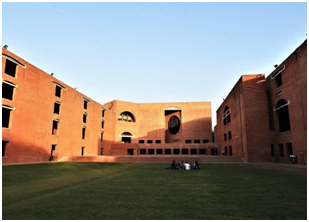
Fig 16: IIM ‘Ahmedabad’
“National Assembly of Bangladesh”‘assembly hall’ is situated in Dhaka, Bangladesh. It represents a symbol of pride and democracy for the Bengali people. It is an appropriate example of modern architecture highlighted in the architecture essay in terms of Bengali vernacular aspects . The building is structured in a modernist way by incorporating the autonomous dichotomy of the architects belonging to the modernized era. It possesses a wide variety of cultural and architectural combinations in building up the construction. It is comprised of 8 halls that are aligned around the grand chamber of the parliament concentrically. The objective of Louis Kahn identified in the context of architecture essay was to optimize the configurations of space along with the incorporation of offices, restaurants, and hotels within the center of the volume.
The complex is fabricated from inlaid white marbles and poured concrete providing a testament to the local values and materials. The monument is surrounded by a cooling system or an insulator for creating lighting and spatial conditions. It is comprised of several geometric shapes for representing a dramatic influence on the culture of the Bengal . The voids of the columns of the building are rooms for the light and therefore it makes the column the maker of light taking complex shapes giving light to the spaces.
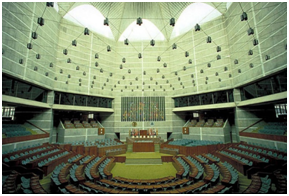
Fig 17: Interior of ‘Assembly Hall’
The implementation of modern technology and design is a part of ‘architecture movement’ in the 20th and early 21st century. As discussed in the architecture essay, it was a difficult task for the architects of that time to establish new design and technologies, which will be widely accepted by the people of that time. While other famous architects were engaged in providing innovations, and change contemporary architecture completely. Kahn had accomplished his innovation and ideas by providing modern architecture with a blend of old patterns. It enhanced his differentiation with other famous architects and grow a new category. The revolution in the architecture field in the 20th century had changed the perception of architecture design and innovation completely. People were started getting used to minimal design and sustainable construction processes. The modern architects of the 21st century have inspired the greatest creation of those famous architects and started to establish an individual signature style. Those famous architects, including Kahn, explored in the above context of architecture essay had amazed the modern minds with their unique works, which were ahead of their time.
References
Allcadblocks. 2020. World Famous Architecture .Architecture essay Accessed May 29, 2020. https://www.allcadblocks.com/product/richards-medical-research-laboratories-louis-i-kahn/.
Archiweb. 2020. Yale Center for British Art. Accessed May 29, 2020. https://www.archiweb.cz/en/b/centrum-anglickeho-umeni-yale-university.
Bintu, Nurjahan. 2018. Kimbell art museum. September 15. Accessed May 2020, 2020. https://www.slideshare.net/NurjahanBintu/kimbell-art-museum.
Comberg, Ella. 2018. AD Classics: Yale University Art Gallery / Louis Kahn. May 25. Accessed May 29, 2020. https://www.archdaily.com/83110/ad-classics-yale-university-art-gallery-louis-kahn. Desai, Jigna. 2019. Equity in Heritage Conservation: The Case of Ahmedabad, India. Routledge.
Docomomo US. 2017. Making Connections with Louis I. Kahn: Private Tour of the Wharton Esherick Museum and 1956 Kahn-designed Workshop. October 14. Accessed May 29, 2020. https://www.docomomo-nytri.org/event/614/.
FreehandArchitecture. 2020. 'Jatiyo Sangsad Bhaban Building' by Louis Kahn and Muzharul Islam. Accessed May 29, 2020. https://www.pinterest.com/pin/499125571184398930/.
Gintoff, Vladimir. 2016. Louis Kahn's Yale Center for British Art Reopens After Restoration. May 16. Architecture essayAccessed May 29, 2020. https://www.archdaily.com/787592/louis-kahns-yale-center-for-british-art-reopens-after-restoration.
India Architecture News. 2019. Louis Kahn’s IIM Ahmedabad: SNK Completes Restoration & Upgradation Of Vikram Sarabhai Library. June 5. Accessed May 29, 2020. https://worldarchitecture.org/article-links/eccgn/louis-kahn-s-iim-ahmedabad-snk-completes-restoration-upgradation-of-vikram-sarabhai-library.html.
Interesting Engineering. 2019. 5 Interesting Facts About Louis Kahn’s National Assembly of Bangladesh. Decemeber 11. Accessed May 29, 2020. https://interestingengineering.com/5-interesting-facts-about-louis-kahns-national-assembly-of-bangladesh.
JAURÉGUIBERRY, XAVIER DE. 2011. IBRARY AT PHILLIPS EXETER ACADEMY. Accessed May 29, 2020. https://divisare.com/projects/304785-louis-kahn-xavier-de-jaureguiberry-library-at-phillips-exeter-academy.
Kimbell Art Museum. 2020. ARCHITECTURE. Accessed May 29, 2020. https://www.kimbellart.org/art-architecture/architecture/kahn-building.
Lesser, Wendy. 2017. Walking Through the Kimbell. March 3. Accessed May 29, 2020. https://fsgworkinprogress.com/2017/03/23/walking-through-the-kimbell/. —. 2017. You say to brick: The life of Louis Kahn. Farrar, Straus and Giroux.
LoMonaco, Julianna Marie. 2019. "“No Such Thing as Level”: An Architectural Collaboration between Wharton Esherick and Louis Kahn."
Linxue, L I, and T A O Simin. 2018. "Towards Thermodynamic Architecture: Research on Systems-based Design Oriented by Renewable Energy."architecture essayIOP Conference Series: Earth and Environmental Science. IOP Publishing. 012060.
Mohajeri, Shima. 2018. Architectures of Transversality: Paul Klee, Louis Kahn and the Persian Imagination. Routledge.
National Park Service. 2014. National Register of Historic Places Program. September 2. Accessed May 29, 2020. https://www.nps.gov/nr/feature/places/14000537.htm.
Oxford University Press. 2020. Artist's Work/Artists Voice: Louis I. Kahn. Accessed May 29, 2020. https://www.oxfordartonline.com/page/Artists-Work-Artists-Voice:-Louis-I.-Kahn:-Lesson-3.
Sethia, Nitisha, and Sejal Jain. 2016. "Solving problems through choice architecture." (Indian Institute of Management Ahmedabad).
The Athenaeum of Philadelphia. 2020. Louis I. Kahn Collection. Accessed May 29, 2020. https://www.philadelphiabuildings.org/pab/app/co_display_images.cfm/480049?IMAGE_GALLERY_SORTBY=StartYear&IMAGE_GALLERY_PAGE=24.
University of Pennsylvania. 2020. Richards Medical Research Laboratories. Accessed May 29, 2020. https://www.facilities.upenn.edu/maps/locations/richards-medical-research-laboratories.
Wharton Esherick Museum. 2020. Wharton Esherick Studio. Accessed May 29, 2020. https://whartonesherickmuseum.wordpress.com/about/wharton-esherick-studio/.
Wong, Tiffany Seok Yee. 2017. "Academic Literacies in the field of Interior Architecture: A multimodal analysis."architecture essay In Text-Based Research and Teaching, by Tiffany Seok Yee Wong, 341-361. Springer.












